South and Southeast Asian codes telegraphic codes, main
Am gathering descriptions of codes from South and Southeast Asia here, in part to reduce the file size of their previous codescan_notes location, but also to acknowledge their quality, their interest and (last but not least) their compilers. Will include some codes that are not available as scans, but that are in my experience and even keeping.
upper vertical bar ╹ at left returns to top of page; middle ╹ to overall directory of scans; lower ╹ to main telegraphic codes and message practice page.
listed below —
| 1833 | The Hooghly River Code, Charles L. Smartt, comp. |
| 1868 | Alphabetical Code of Signals for the use of government pilot, surveying, light, buoy, and other vessels, telegraph stations, &c., C. W. Warden, comp., Calcutta |
| 1874 | Code télégraphique privé d’une maison de commerce, impr. de Lemale (Le Havre, 1874), possibly for Borradaile, Schiller & Co. (Calcutta) |
| 1896 | Telegraphic Code; compiled by Anundjee Roognathjee, Freight Broker, Calcutta |
| 1898 | The South Indian Telegraph Code, in English, Tamil and Telugu, P. B. Krishnasawamy Naidu, comp. |
| 1910 | Private Jute Code, A. C. Sen., comp. |
| 1924 | Indian Word Code, Sixth Edition |
The Hooghly River Code BL, (Asia, Pacific & Africa T 35398) via google.books : link Physical Description: vii, 106 p., [1] leaf of plates : ill. ; 22 cm. digitized August 19, 2014 |
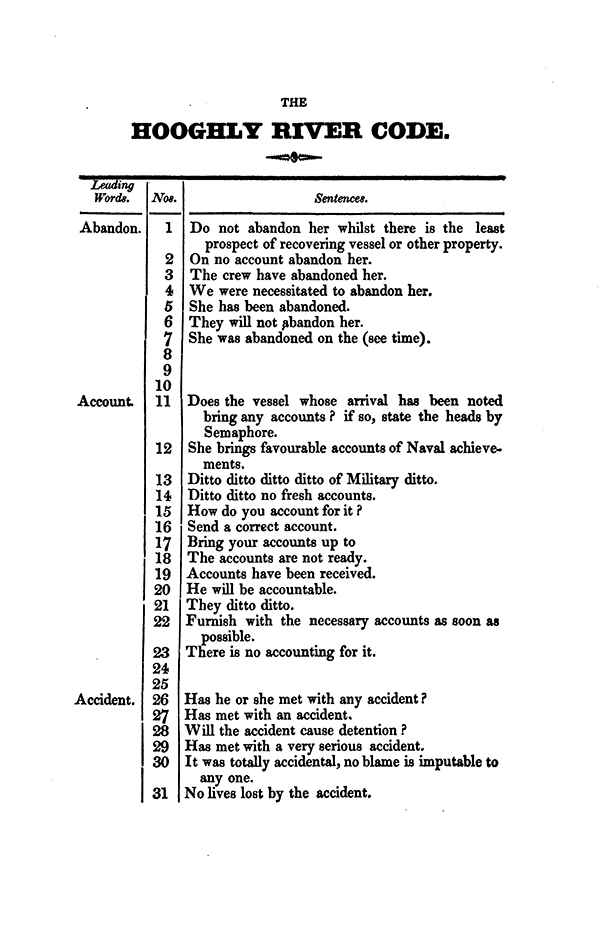 |
⬆
first code page, The Hooghly River Code (1833)
four derivations from The Hooghly River Code at asfaltics : link
(January 2015) and archived at 0997-1000 : link
Alphabetical Code of Signals for the use of government pilot, surveying, light, buoy, and other vessels, telegraph stations, &c., Second Edition. British Library copy, digitized August 19, 2014 (via google books) : link x, 271 p. : ill. ; 25 cm. |
“The present system of letters” shows a decided improvement” over the previous 1845 edition, which employed a flag numeral system.
18 signals with one flag.
306 with two flags
the remainder (1,098) shown with three.
This edition has “some three or four hundred more sentences requiring only three Flags.”
uses Marryatt’s flags, but so arranged, that it is not possible for a sentence in the Pilot’s Code to be made, which, on looking into Marryatt’s Signal Book, could convey any sense of its purport; there is therefore no possibility of confusion.”
Preface to the Second Edition, i-ii
Explanation of Parts of Code, iii-iv
General instructions, v-viii
Addenda, viiia-viiib
River Surveyors’ Signals
Part I Principal officers of the State, also Pilot Service. (many names handwritten), pp 1-9
Part II Government Vessels, pp 11-13
Part III. Names of Buoys. (some lovely names), pp 15-29
Part IV. Names of Places, Creeks, Marks, &c. (e.g., Sumatra Sand, Jar Makers, Jar Makers’ Reach, Jar Makers’ Point, Jiggercolly, Kidderpore Dock...), pp 31-61
Part V. Sentences, pp 63-244 (the major part of the code)
(Part V, continued) River Surveyor’s Signals, pp 245-256
Part VI Compass Signals, pp 257-266
Part VII Night Signals, pp 267-271
Code télégraphique privé d’une maison de commerce BnF copy (via Gallica) : link code/phrases pp 1-306, index pp 307-314 — The “title” given to the code appears to be a cataloger’s description; the code (or scan of the code) is missing a title page and (almost) any information about its publisher/printer, or the firm for which it was created. the name “Ansell, U.-J.” is written at upper left of first (surviving) page of the code; and a communication to “Ferdinand Schiller, Esq” regarding messages for India, using groups which are “charged for at the rate of 5 figures to a word.” William Thomas Ansell (1822-1904) and Harold W. Ansell were connected with the firm; I find no mention of a U.-J. Ansell. I surmise that the code was compiled by/for Borradaile, Schiller & Co. or a successor firm in Calcutta. Ferdinand Schiller was president of the Bengal Chamber of Commerce 1866; was involved in a Port Canning development scheme (that came to nothing? — wikipedia); and was father to the philosopher F C S (‘Canning’) Schiller (1864-1937, wikipedia), Ferdinand Nassau Schiller (1866-1938), also a merchant, who formed a noted collection of Chinese art (jade, etc.), and F P M ‘Max’ Schiller, K.C. (1868-1946). Information on Schiller derived from various sources including Peter Hardie, his “Ferdinand Schiller, Collecting Chinese Art 1913-1936,” Journal of Museum Ethnography, No. 15, Papers Originating from MEG Conference 2002: Power and Collecting, National Museum of Scotland, Edinburgh (March 2003 : 35-46 : link (jstor) |
 |
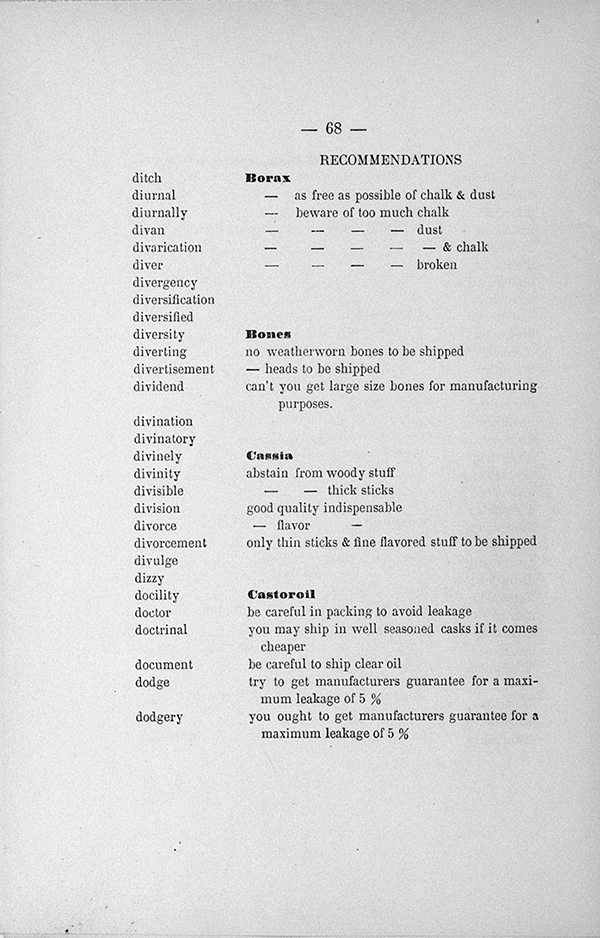 |
⬆
pp 67-68, Code télégraphique privé d’une maison de commerce (1874)
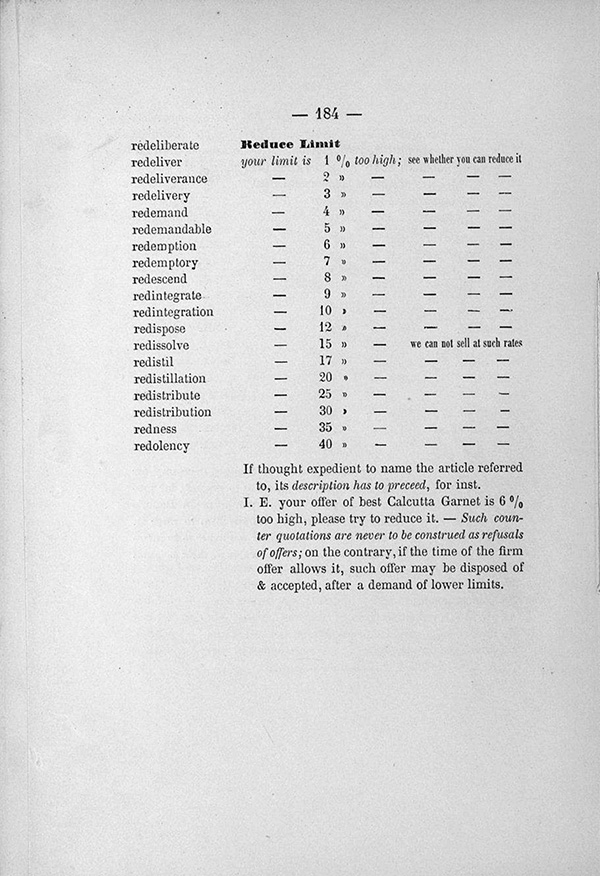 |
 |
⬆
pp 184-185, Code télégraphique privé d’une maison de commerce (1874)
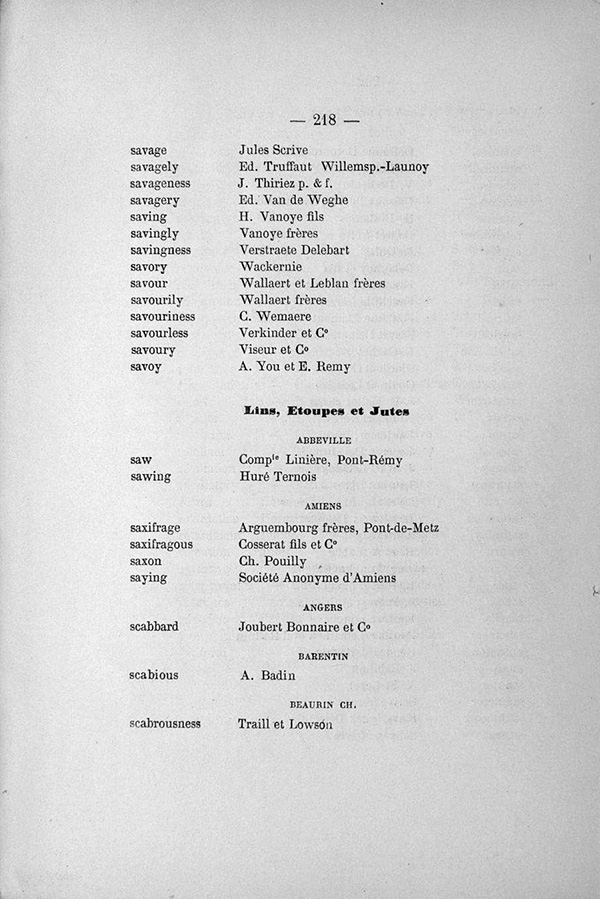 |
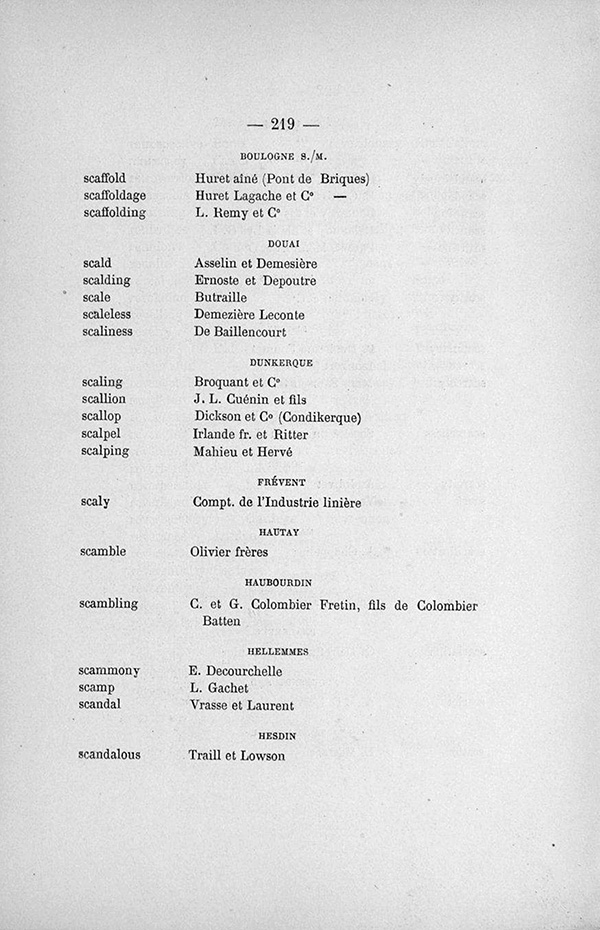 |
⬆
pp 218-219, Code télégraphique privé d’une maison de commerce (1874)
An extensive “index” brings to mind the indexes of various Meyer codes from the same decade (although those are different in format). The entire index is shown below.
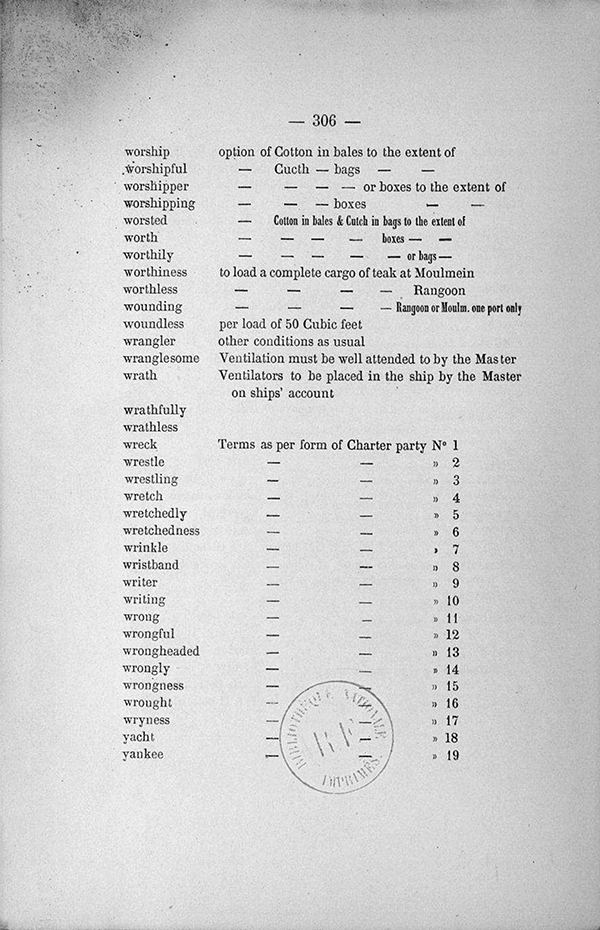 |
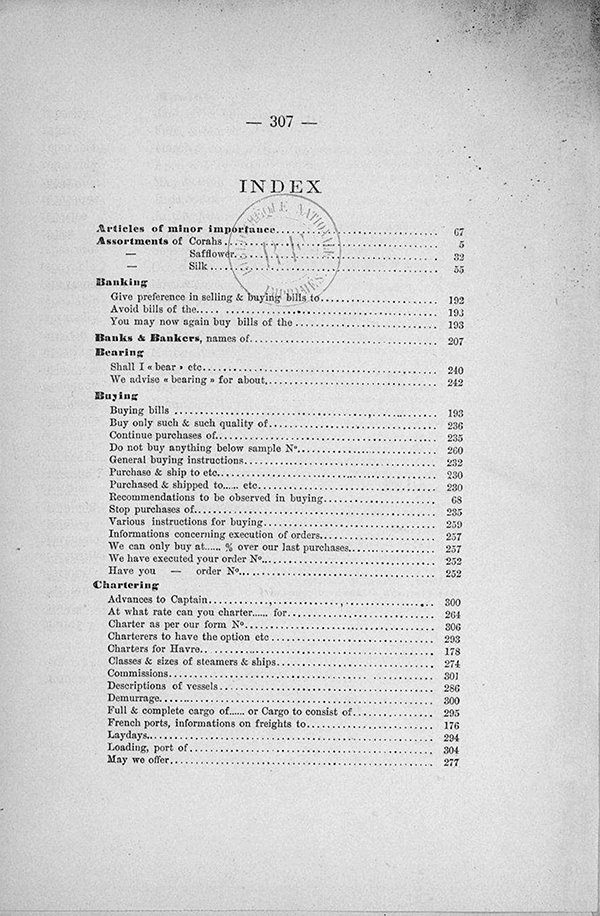 |
⬆
pp 306-307, Code télégraphique privé d’une maison de commerce (1874)
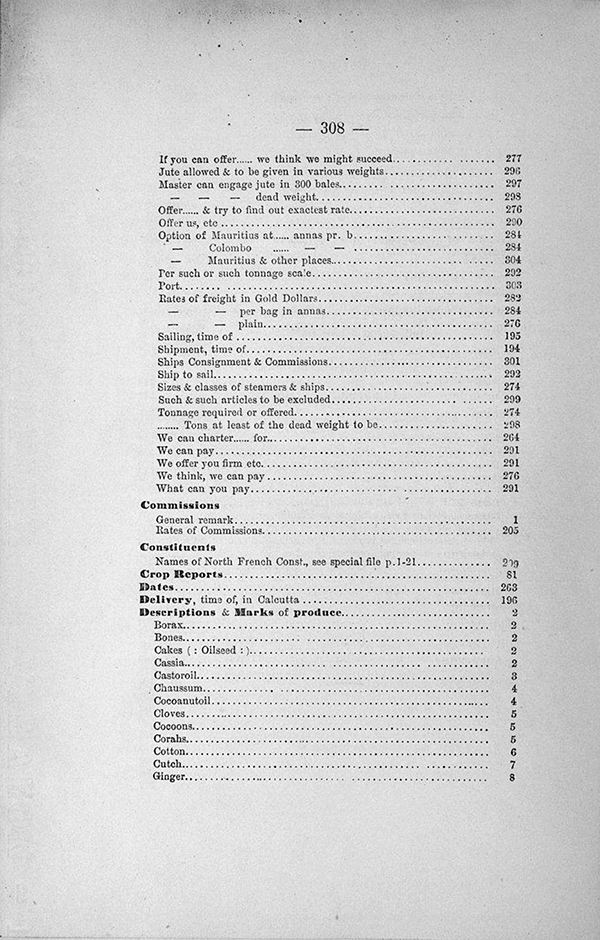 |
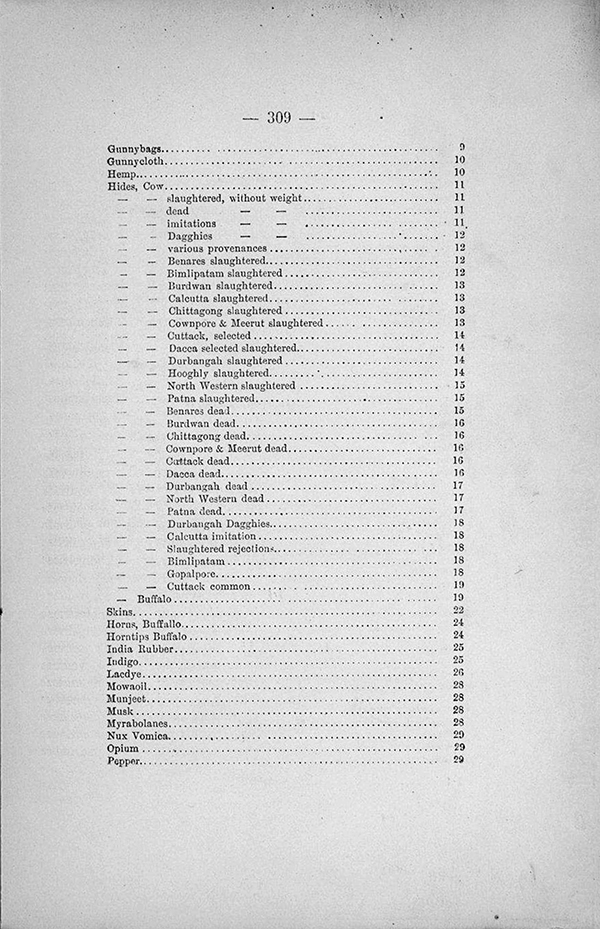 |
⬆
pp 308-309, Code télégraphique privé d’une maison de commerce (1874)
 |
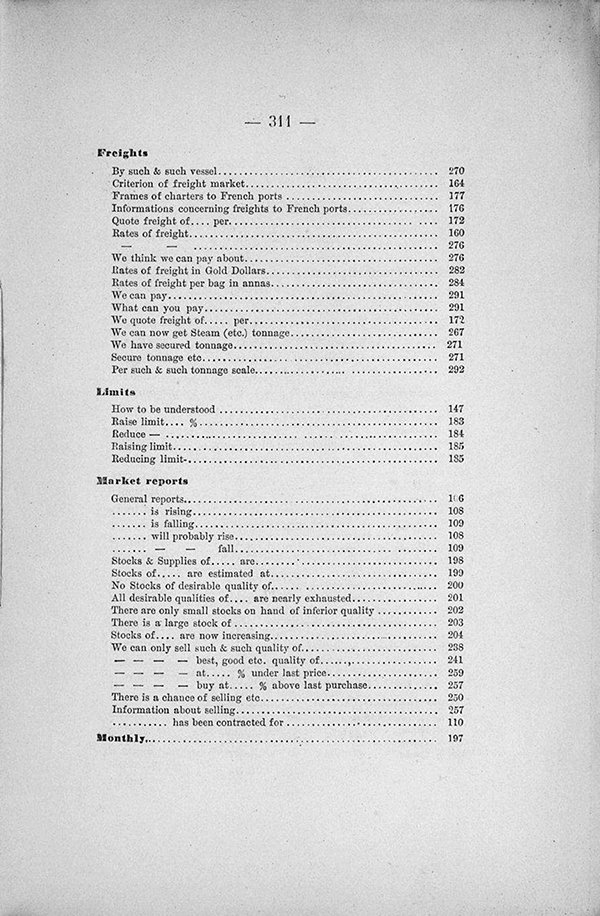 |
⬆
pp 310-311, Code télégraphique privé d’une maison de commerce (1874)
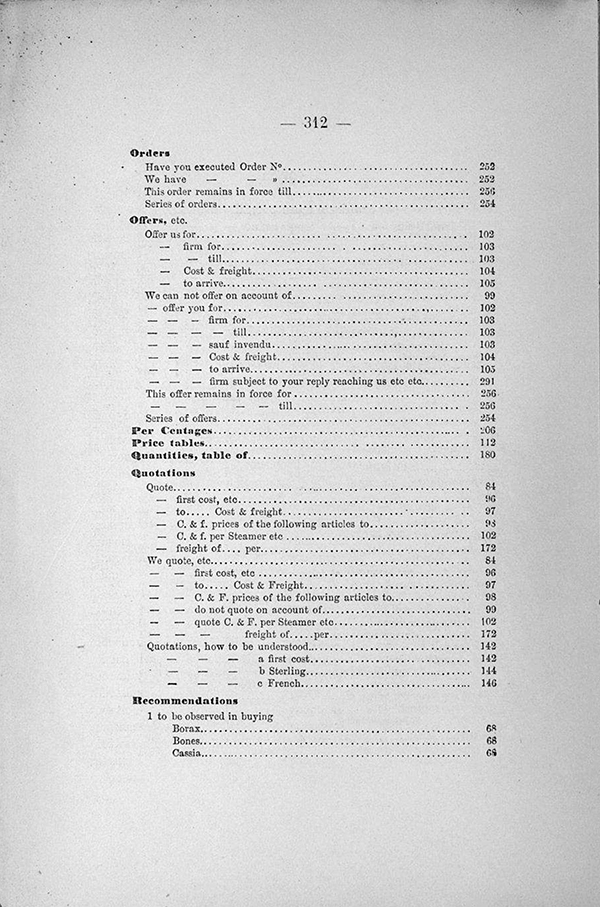 |
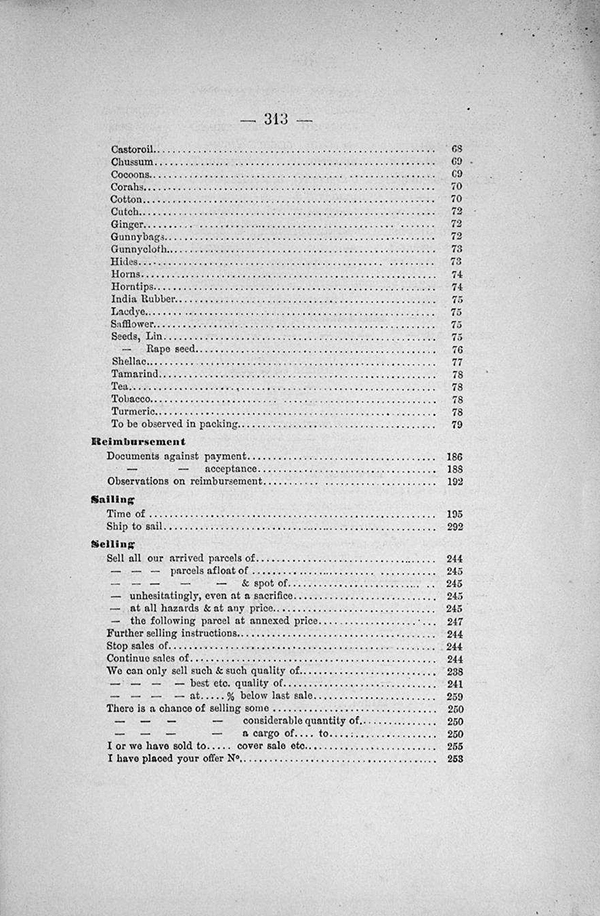 |
⬆
pp 312-313, Code télégraphique privé d’une maison de commerce (1874)
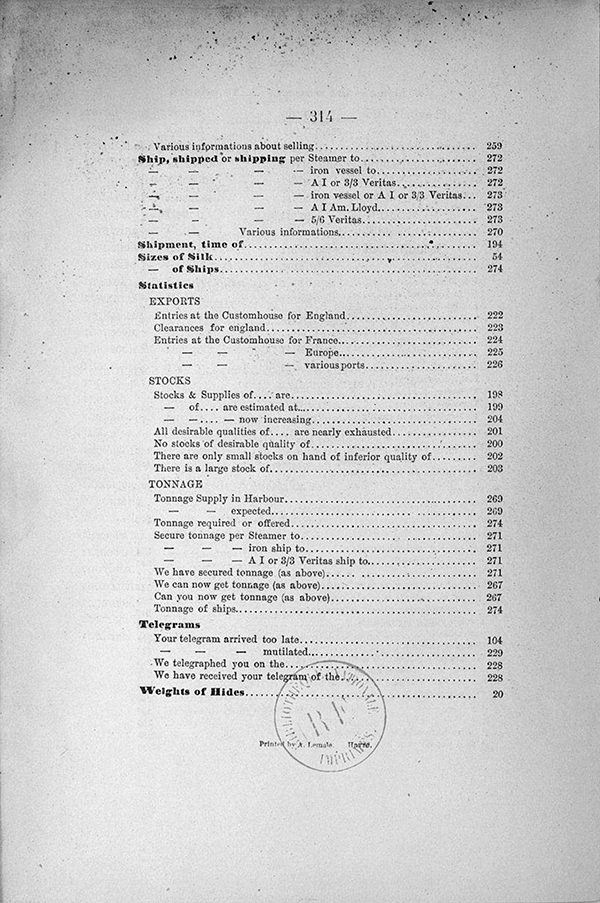 |
⬆
pp 314, Code télégraphique privé d’une maison de commerce (1874)
Telegraphic Code National Library of India, Kolkata scan (via archive.org) : link 288 pages (of code); no table of contents/index. phrases and (some) tables; keywords in alphabetical order; code words from 1894 Official Vocabulary |
brief description, extracts/derivations at asfaltics :
2247
2254 and
2255
The South Indian Telegraph Code, Roja Muthiah Research Library copy/scan (via archive.org) : link trade, commerce; polyglot i-ii Preface (in English) a beautiful code, in what appears to be stanzaic form, three lines per stanza. Roja Muthiah Research Library, Chennai (website) : link |
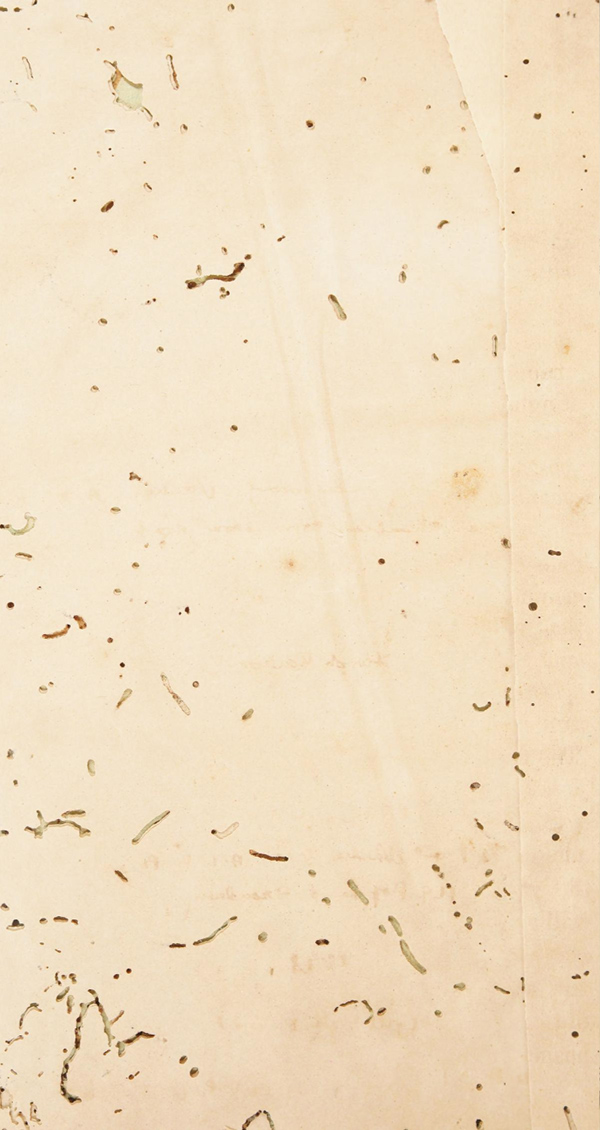 |
 |
⬆
The South Indian Telegraph Code (1898)
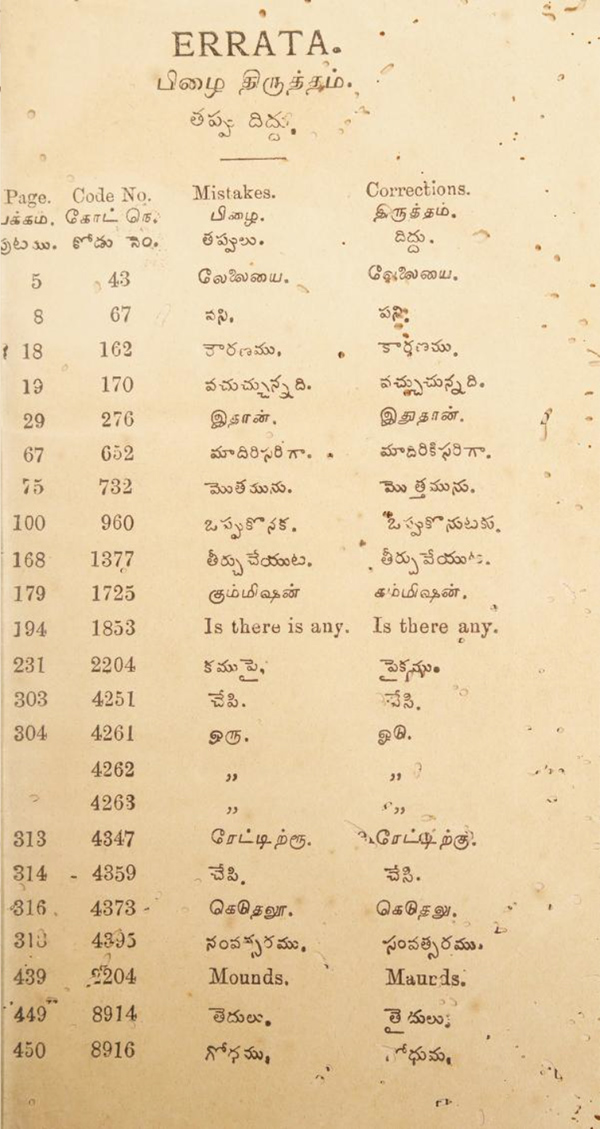 |
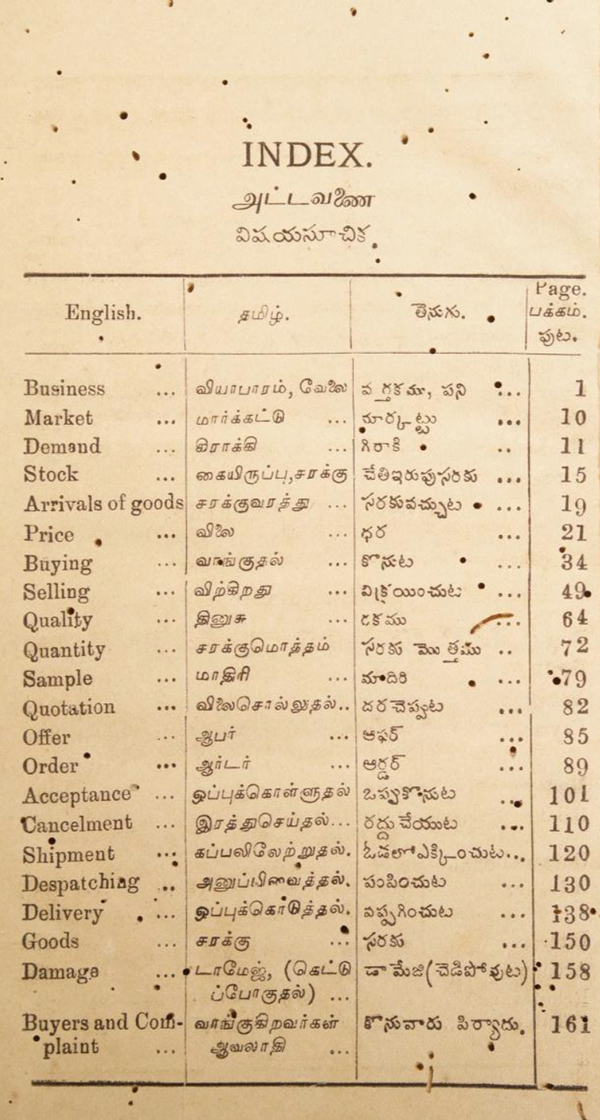 |
⬆
errata, and p xi (Index), not facing pages
The South Indian Telegraph Code (1898)
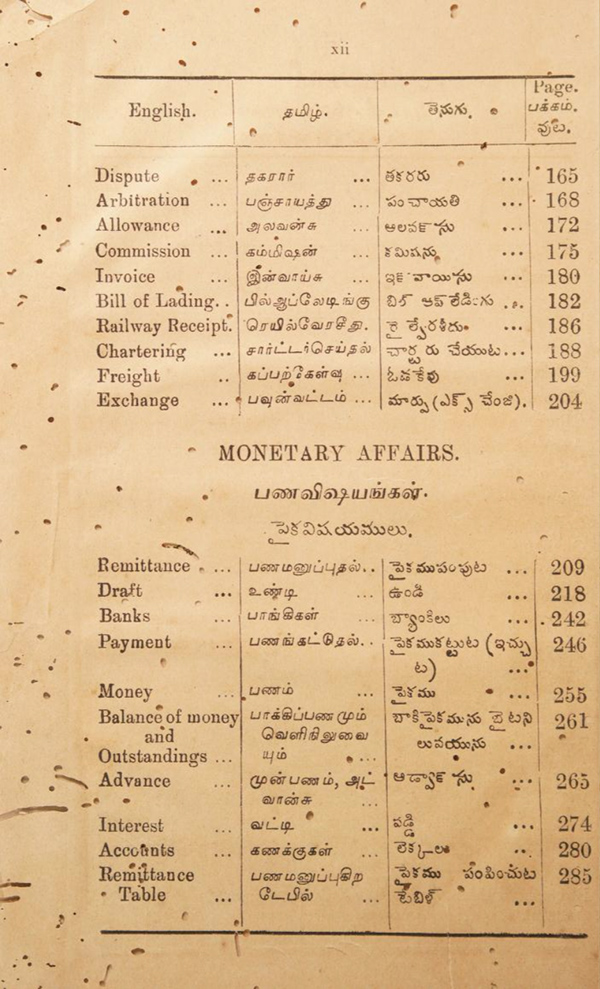 |
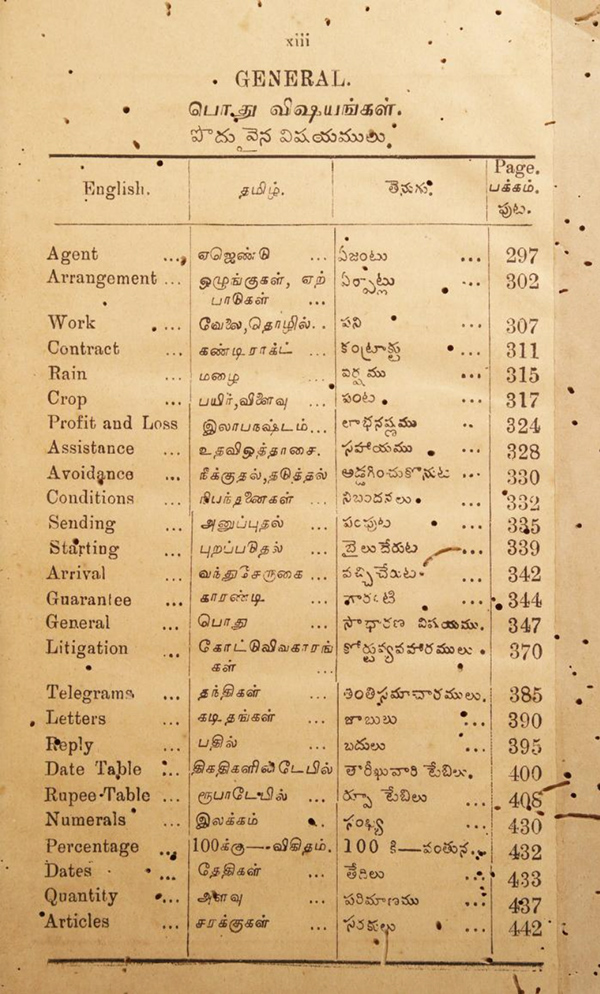 |
⬆
pages xii-xiii (Index), The South Indian Telegraph Code (1898)
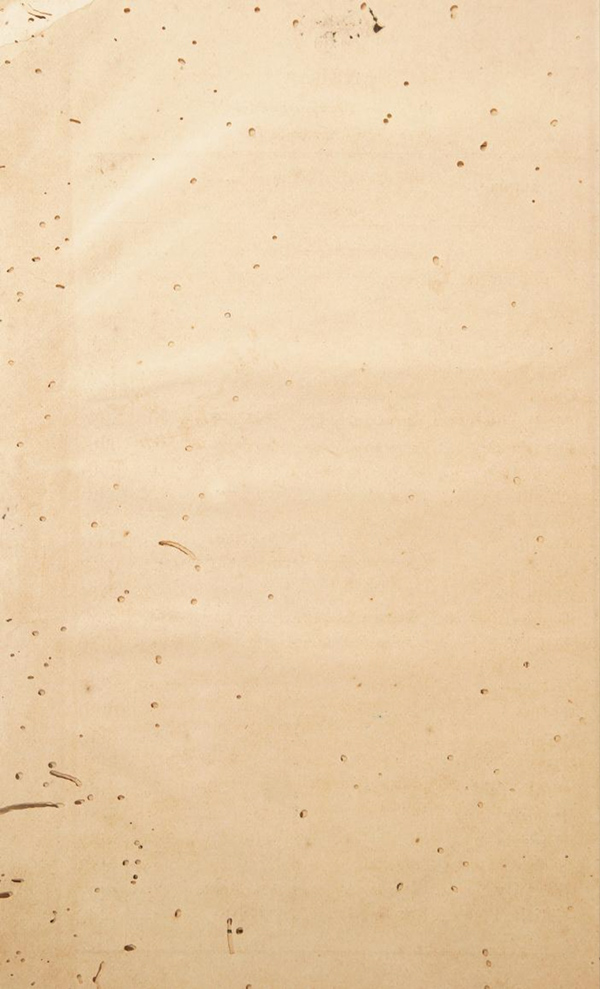 |
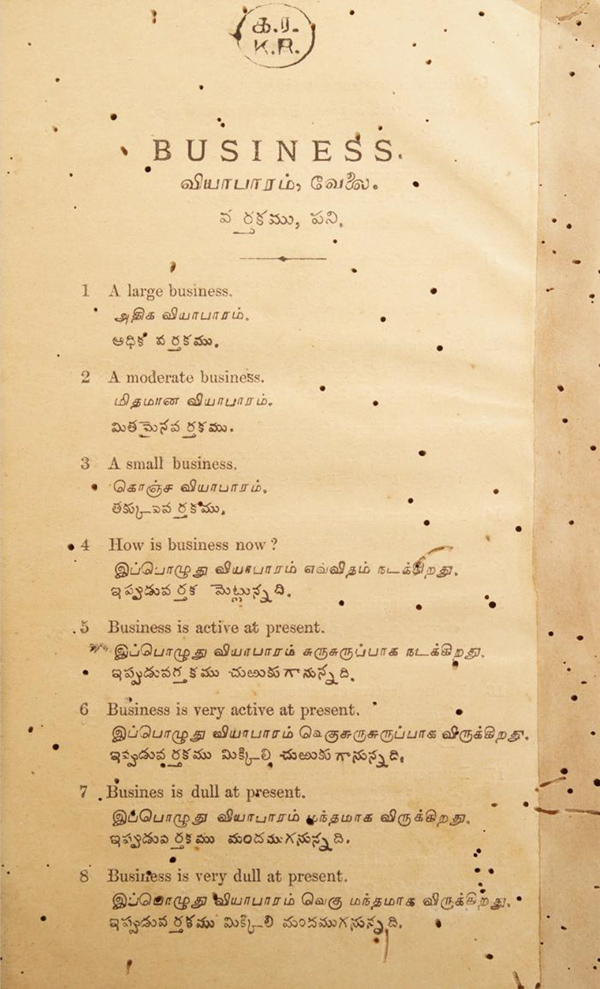 |
⬆
page 1 (of code), The South Indian Telegraph Code (1898)
Krishaswamy Naidu is mentioned in two U.S. trade publications in 1914, when he is evidently involved in tanning and (other?) trade. Transcriptions of those mentions follow.
- Visitor from India.
Oriental Tanner Making World Tour.
Now in Boston.
Mr. P. B. Krishaswamy Naidu, B. A., of the firm of S. Hajee Abdulla Saib & Co.., Madras, India, who is on a 30,000 mile trip visiting his various agencies in France, London, America, Chiba and Japan, was a visitor in the Boston market last week, in company with his American agent, Mr. A. C. Needham.
The firm owns and operates six tanneries in India. Mr. Naidu visited several of the local tanners of India tanned skin, who are interested in getting from an India tanner information as to the process of tanning now in vogue in India. Mr. Naidu is the first Madras tanner tanning on an extensive scale that has visited this market for some years, and information of value as to exactly ow the business is carried on their from the first collection of raw pelts to the final sale to dealers and brokers in Madras by tanners for shipment to America, was given to buyers here.
Hide and Leather 47:1 (March 19, 1914) : 8 : link - A Visitor from India
P. B. Krishnaswamy Naidu, of S. Hajee Abdulla Saib & Co., Madras, India, tanners and merchants, visited leather factories of Salem and Peabody last week. He was accompanied by A. C. Needham, of Boston, American agent for his firm. Mr. Krishnaswamy is on a 30,000 mile trip among the countries of the world, observing industrial progress. He stopped in Peabody, to observe leather making methods, and, also, to inquire what leathers from India could be used to best advantage by Peabody manufacturers, his firm operates several tanneries in India, and sends large quantities of sheep, kid, kip and buffalo pelts to London auctions. Plans are being made to equip the tanneries with American machinery. Young men have been sent to the Leather Sellers’ College, London, to learn modern leather making. They will be employed in the tanneries.
Shoe and Leather Reporterr 47:1 (March 21, 1914) : 19 : link
![]()
Preface (English language, transcription)
The undersigned has much pleasure in presenting this book to the Public and the Mercantile public more particularly. In India the local and to some extent foreign trade is being carried on by merchants unacquainted with English, and in consequence, they are, comparatively speaking, in a backward condition, as they do not possess such facilities as the English-knowing merchants do, such as Telegraph Codes, &c. Therefore the writer has thought that a book like the present one is indispensably necessary for the safe conduct of business. This is the very first attempt that has been made of compiling a Code in English and native vernaculars together, so as to curtail the telegraphic expenses and thus induce facilities for trade by cheap means of quicker communication. The use of this code will enable the public to wire full informations on any given subject at a minimum cost, which would otherwise prove impracticable and costly to forward by means of telegram, and the writer has not the least doubt that this book will serve as a help to the development of business in every way as the Codes in other languages. Though this work was specially undertaken at the request of a large number of native merchants who have had business connections outside India, such as Singapore, Rangoon, Colombo, Mauritius, Natal &., the compiler has taken advantage of the opportunity to include other subjects for purposes of internal trade as well. The book will be found highly useful to the general Public also, as general expressions of every day life, legal communications, &c, have been likewise included.
In making up this Code great care has been taken to secure accuracy of expression in simple and plain language. The writer’s close connection with large Export and Import houses, both European and Native, and his experience of the requirements of the local and foreign trade, have enabled him to compile this work and he therefore hopes for a favourable reception from the discriminating public, as a careful perusal of the book or at least its index will enable every one to appreciate its real merit and to find the increased economy obtainable by an intelligent use of it.
The sentences and phrases contained in the book have been classified under various headings to facilitate speedy coding of a message.
Any suggestions respecting improvements will be thankfully received and included in the future editions.
Purchasers are requested to recommend this book to their friends and correspondents.
p i-ii : link
![]()
other items listed under heading “telegraph” in catalogue of the Roja Muthiah Research Library, Chennai :
- Trathic code [for “traffic” ?] / Government of India, Telegraph Department, 7th ed
Calcutta : Superintendent, Government Printing, 1900
xxvii, 272 p. ; 24 cm.
RMRL Shelf mark.9242 : link - தந்தி போதினி [Danti Bodhini] : Telegraph instructor
சென்னை [Chennai] : s.n, 1900
136 + p. ; 22 cm.
RMRL Shelf mark.37973 : link - தபால் தந்தி மித்திரன் : இதனுடன் தவணை, நடப்பு வட்டிகள் விபரமும், தந்தி எழுதும் மாதிரியும், நகரக்கோவில்களின் விபரமும் இன்னும் பல முக்கியமான விஷயங்களும் சேர்க்கப்பட்டிருக்கின்றன
இரங்கோன் : வைசிய நேசன் கம்பெனி, 1919
machine translation :
[Postal Tandhi Mitran : It includes details of installments, current interest rates, sample of writing telegrams, details of city temples and many more important things.
Irangon : Vaisya Nation Company, 1919]
xii, 84 p. ; 28 cm.
RMRL Shelf mark.89434 : link
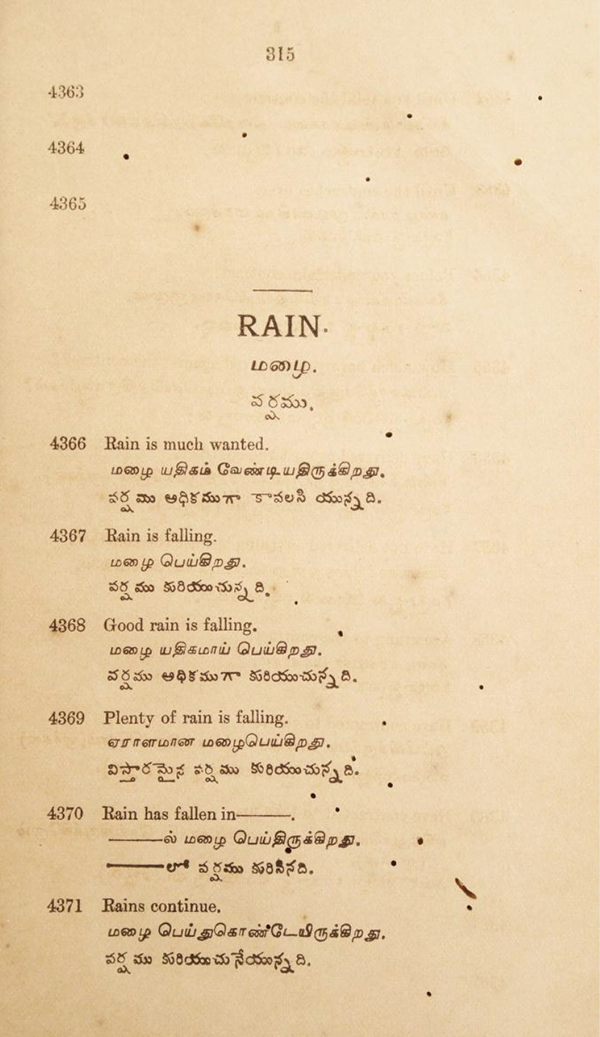 |
 |
⬆
“Rain” (pp 315-316, not facing pages)
The South Indian Telegraph Code (1898)
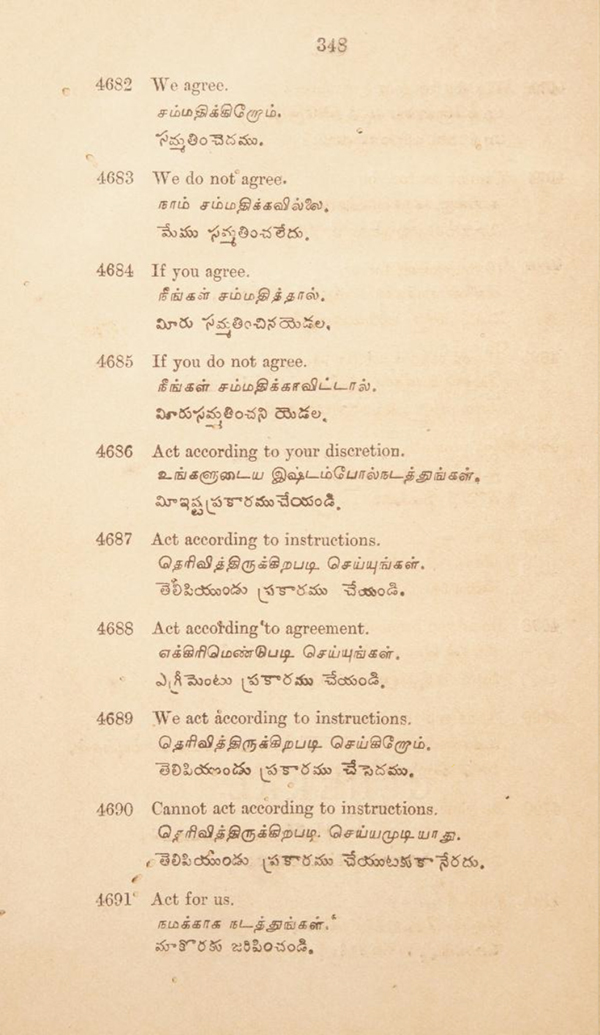 |
 |
⬆
pp 348-349, The South Indian Telegraph Code (1898)
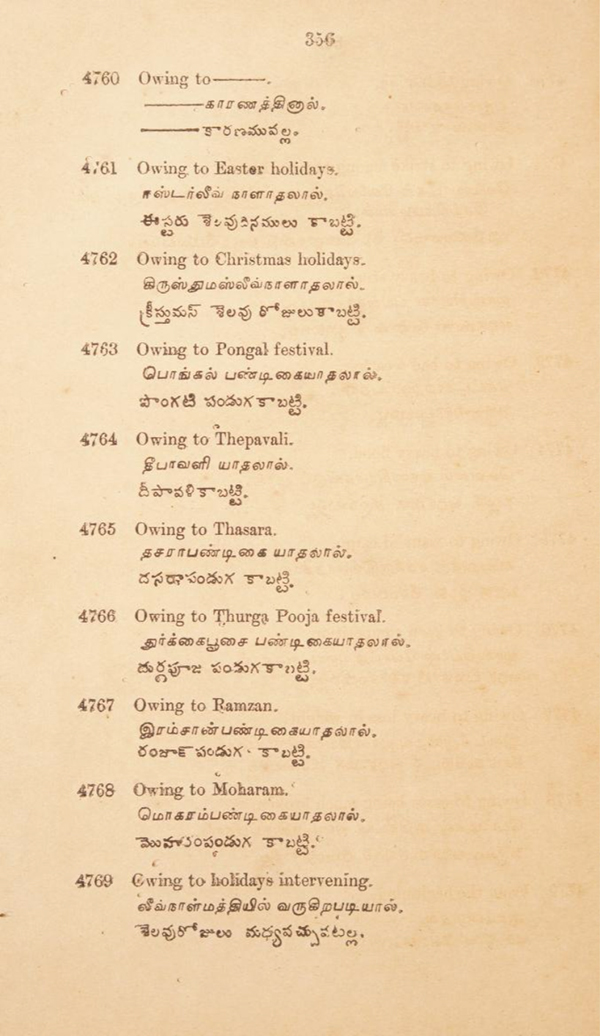 |
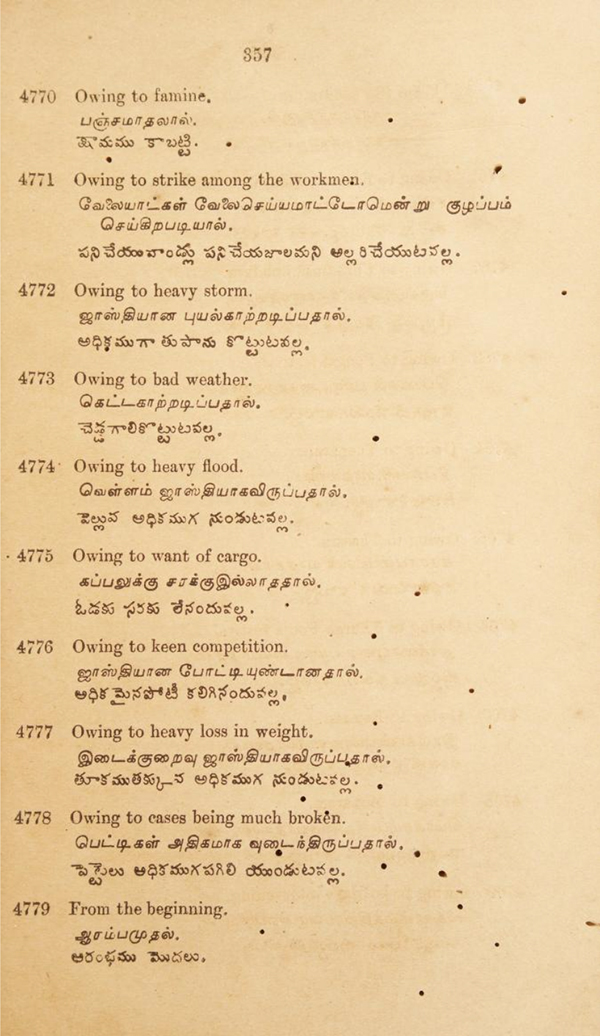 |
⬆
pp 356-357, The South Indian Telegraph Code (1898)
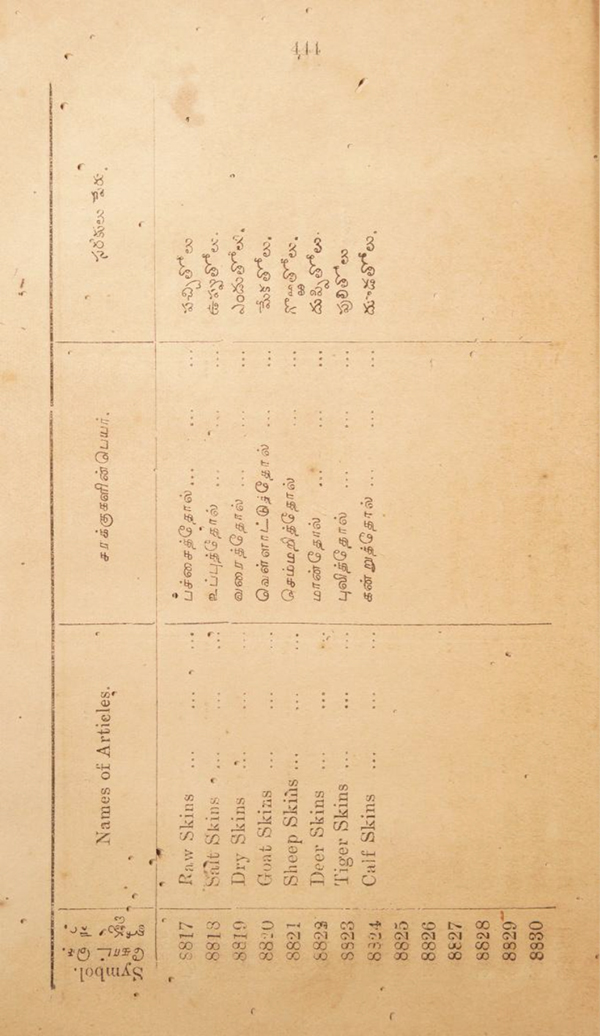 |
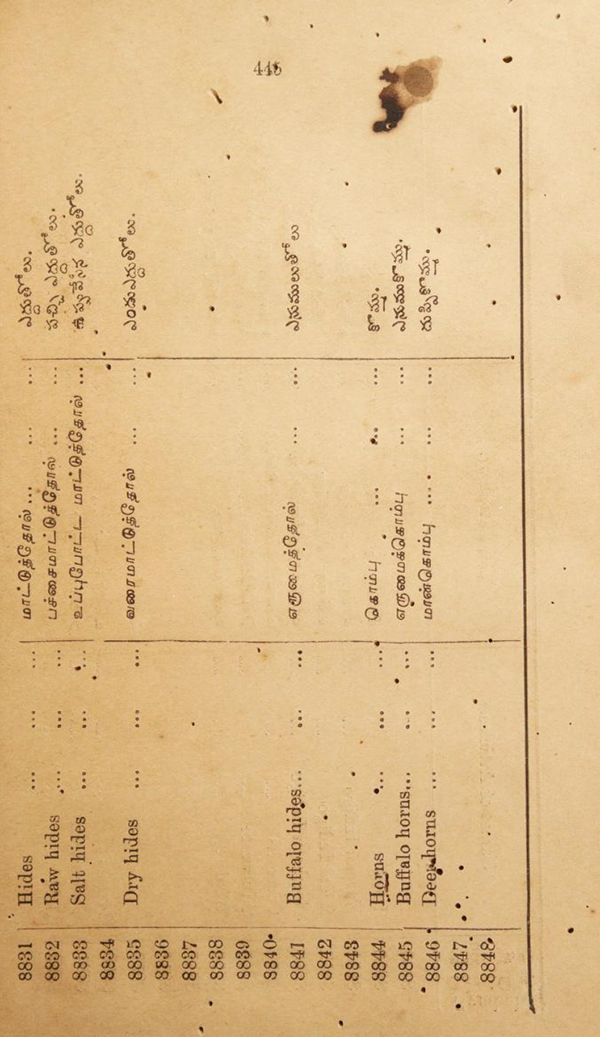 |
⬆
“Names of Articles,” pp 444-445, The South Indian Telegraph Code (1898)
| Private Jute Code compiled by A. C. Sen. Manager, Khetter Mohun Dey & Co. Chandpur. Tipperah. [now Chandpur District, Chittagong Division, Bangladesh] Printed by N. N. Sil at the Fine Art Press. 2, Latoo Baboos’s Lane, Calcutta [1910] Bengal Library accession stamp (4 August 1910) i-x, 1-209 pages Table of contents in alphabetical order; sections in a different (though logical) order figure code with its own condenser (and suggestions about multiple ways of coding) |
The Phrases start where they should, with 00001 / Sowing, at the first page.
—
from the preface —
“Every possible care and best endeavours have been taken in its compilation and to make the ‘Code’ complete and as far as possible self-contained, and in it the author has attempted to introduce, in their proper places, such matters as his experience in business for over 20 years has deemed necessary.”
![]()
A. C. Sen is also author of A Report on the System of Agriculture in the Dacca District, which drew favorable notice in the Indian Forester (March 1894, 116-117) and which is cited in subsequent literature, e.g., Radhakamal Mukerjee, The Changing Face of Bengal : A Study in Riverine Economy (1938) : 54
a wonderful code, for the depth and beauty of its phrases. Some extracts at asfaltics : link
| Indian Word Code, Sixth Edition 1924 Bengal Legislative Library copy, via archive.org : link 5L code; i-xxxv (instructions; holders of code) further details soon (20240121) Fourth edition at government codes : link
|
20240121